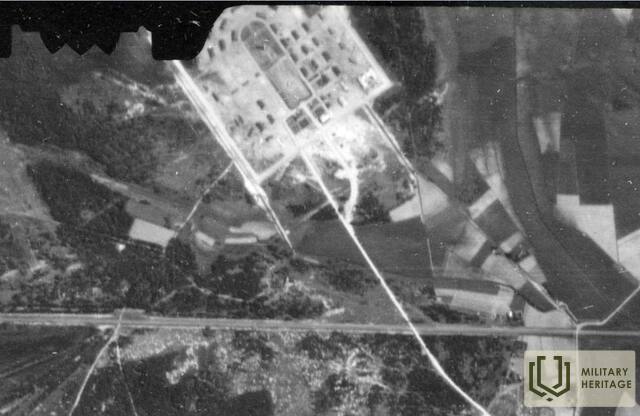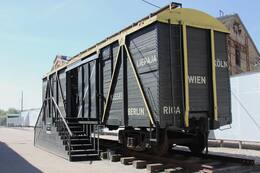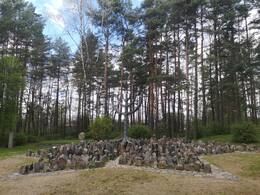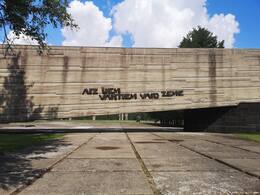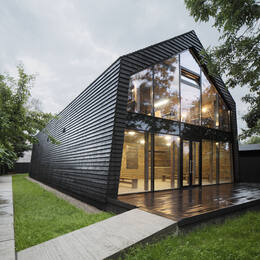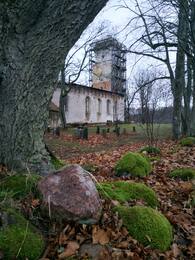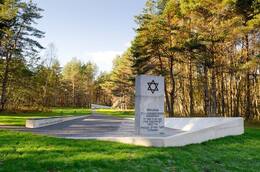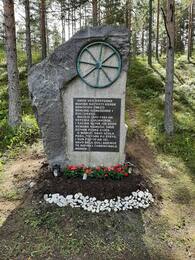Концентрационный лагерь
I Первая мировая война, I Освободительные войны, Первая независимость, II Вторая мировая война, IV Советская оккупация
Концлагерь - это обособленный и охраняемый комплекс тюрем под открытым небом для изоляции больших масс - комплекс огражденных и охраняемых от внешнего мира временных построек, где можно изолировать большое количество гражданских лиц или пленных военнослужащих ( комбатанты). Цель концлагерей превентивная: предотвратить вовлечение военных или гражданских (политических противников) в действия, враждебные государству или режиму, предотвратить потенциальную угрозу государству (или режиму), которую представляет свобода этих групп людей . До Второй мировой войны концлагеря считались приемлемым способом изоляции больших групп людей во время войны или беспорядков. И только после войны, когда вскрылась правда о массовых смертях в нацистских, а затем советских концлагерях, название лагерей приобрело новое значение с крайне негативным отношением.
Первый известный в истории «reconcentrados» или «концентрационный лагерь» был создан генералом испанской армии Валериано Вейлером в 1895 году для подавления восстания на Кубе. После этого концлагеря стали массово использоваться британской армией во время так называемой Англо-клеточной войны (1899-1902 гг.). Концентрационные лагеря были созданы всеми воюющими сторонами во время Первой мировой войны, так как большое количество вражеских солдат попало в плен различными армиями. В Финляндии были созданы лагеря для пленных красноармейцев во время Гражданской войны, и в суровых условиях этих лагерей погибло большое количество интернированных. Еще до переворота 1934 года народ Латвии имел опыт или представление о таких лагерях: многие латышские солдаты Российской империи провели много лет в лагерях для военнопленных в Германии. В Латвии во время Освободительной войны (1919-1920) были созданы концлагеря как на территории, подконтрольной Временному правительству, так и в ЛСПР, куда интернировали политически неблагонадежных лиц.
В России создание концлагерей началось в 1919 г. в соответствии с постановлением ТКП СССР от 15 апреля «Об учреждении исправительных лагерей». В 1934 году, после убийства министра внутренних дел в Польше, 3091 украинский и польский националист, а также коммунист на пять лет были помещены в концентрационный лагерь в Березе Картуске. Так называемые Валмиерский концлагерь и Лиепайский концентрационный лагерь были созданы в Латвийской Республике в 1919 году. В 1934 году. Во второй половине 1930-х годов, вплоть до окончания Второй мировой войны, нацисты создали в Германии разветвленную сеть «Konzentrationslager» сначала для изоляции политической оппозиции, затем для заключения в тюрьмы военнопленных и просто неугодных режиму работников. В Латвии были созданы концлагеря в Саласпилсе, Юмправмуйже и Межапарке. Многие из этих концлагерей продолжали действовать после капитуляции Германии, только заменив контингент заключенных. В оккупационной зоне СССР лагеря были подчинены управлению ГУЛАГа в 1948 г., но были ликвидированы в 1950 г. (лагерное оборудование было вывезено в СССР, где продолжали использоваться ГУЛАГовские концентрации в лагерях.
Дополнительные источники информации
https://vesture.eu/Koncentr%C4%81cijas_nometne
https://lv.wikipedia.org/wiki/Kategorija:Tre%C5%A1%C4%81_reiha_koncentr%C4%81cijas_nometnes_Latvij%C4%81
Связанная хронология
Связанные объекты
Музей Рижского гетто и Холокоста в Латвии
Музей Рижского гетто и Холокоста в Латвии находится в Риге, недалеко от Рижского центрального рынка и Рижского пассажирского вокзала. Музей открыт в 2010 году на месте городских складов. Он расположен в исторической части города, рядом с границей бывшего еврейского гетто. Территория гетто уникальна тем, что архитектурно не изменилась со времен Второй мировой войны. Это памятник трагедии еврейского народа. Политика Германии по Еврейскому вопросу в Латвии до конца 1939 года выражалась в попытках немецких дипломатов и политиков повлиять на правительство Латвии, чтобы оно приняло меры против евреев, ограничив их свободу. С эмиграцией балтийских немцев в 1939 году информированность посольства Германии о настроениях населения и событиях в Латвии, уменьшилась. Когда Красная Армия оккупировала Латвию и манипулировала обществом, некоторые евреи поддержали новую оккупационную власть. Перед лицом наступления режима на общество в целом поддержка резко упала. Однако среди населения образовался глубокий раскол, который позже стал использоваться следующим оккупационным режимом - немецким. Германия надеялась, что евреи будут подвергаться погромам и расправам, но этого не произошло. В планы Германии были внесены коррективы, которые сначала предусматривали создание еврейского гетто, а затем уничтожение евреев.
Еврейский мемориал в Румбуле
Находится в Румбуле, недалеко от улицы Московской.
Румбула — одно из крупнейших мест массового уничтожения евреев в Европе. В ходе двух действий - 1941 год. 30 ноября и 8 декабря, осуществленных на основании решения нацистского руководства о полном уничтожении заключенных в Рижском гетто евреев, в Румбулском лесу было расстреляно более 25 тысяч человек, в том числе около 1000 евреев, депортированных из Германии. 1944 г. Несколько сотен мужчин-евреев из концлагеря Кайзервальд также были убиты в Румбуле.
Первые попытки увековечить память евреев, убитых в Румбуле, относятся к концу 60-х гг. Несмотря на ограничения советского правительства, в результате инициативы некоторых евреев в 1963 г. к одной из сосен Румбулы была прикреплена деревянная памятная доска с надписью на идиш, а возле железной дороги Румбула (у линии Рига-Москва) установлен большой плакат художника Иосифа Кузковскиса «Еврей». На плакате был изображен мужчина, поднимающийся из могилы со сжатым кулаком, что символизировало протест против содеянного. И памятная доска, и плакат уже 1964 года. были собраны, но евреям удалось добиться разрешения на установку в Румбуле памятного камня с надписью «Жертвы фашизма» не только на латышском и русском, но и на идиш.
в 2002 29 ноября в Румбуле открылся мемориальный ансамбль по проекту архитектора Сергея Рижа. Его создание финансово поддержали учреждения Латвии, Израиля, США и Германии, а также частные лица.
На обочине шоссе, у дороги, ведущей к мемориалу, в качестве знака установлена металлическая конструкция, символизирующая силы нацизма. Рядом камень с пояснением, что по этой дороге были загнаны на смерть тысячи евреев. У входа в сам мемориал несколько каменных плит с надписями на латышском, английском, немецком и иврите знакомят с событиями трагедии Румбулы и историей создания мемориала. В центральной части мемориала, над площадью, выполненной в форме звезды Давида, возвышается семисвечник - менора, окруженная камнями с выгравированными именами евреев, убитых в Румбуле. На отдельных камнях, которыми вымощена площадь, высечены названия улиц бывшего Рижского гетто. На территории мемориала имеется несколько массовых захоронений, места которых обозначены прямоугольными бетонными бордюрами.
Саласпилсский (Salaspils) мемориальный ансамбль
Саласпилсский мемориал и историческая выставка находится в Саласпилсском крае, в 1,2 км от автомагистрали А6 Рига-Даугавпилс. Саласпилсский мемориал был открыт в 1967 году на месте Саласпилсского лагеря времен Второй мировой войны. Это место, окружено мифами и полуправдой, используется для советской пропаганды; Пример оккупационных властей в Латвии – это пример нацистских преступлений и коммунистической идеологии. В Саласпилсе был репрессивный лагерь, входивший в пенитенциарную систему Германии. У него были сходства с концентрационными лагерями, но он не являлся таковым. Лагерь был создан для того, чтобы в рижских тюрьмах не находилось чрезмерное количество заключенных. Лагерь представлял собой «расширенную полицейскую тюрьму». Заключенными были самые разные люди - евреи, военнопленные Красной армии, дезертиры, политические заключенные, преступники, проститутки, члены латвийского движения сопротивления, балтийские солдаты на службе немецкой армии или полиции и другие.
Одновременно в лагере находилось до 2200 заключенных. Основными причинами смерти (~ 2000 человек) были недоедание, условия труда, телесные наказания и болезни.
Мемориал им. Жаниса Липке
Мемориал Жаниса Липке находится на Кипсале в Риге. Не исключено, что музей Жаниса Липке – лучше всех «спрятанный» музей в Риге. Скрытность мемориала не только реальная, но и символическая. Он был построен на месте подземного убежища для спасения людей во время Второй мировой войны и немецкой оккупации. Там Жанис Липке и его семья спасли 55 евреев. Сегодня рядом с домом семьи Жаниса Липке возведен мемориал. Мемориальное здание «Черный сарай» представляет собой символическое здание, в котором было предоставлено и получено убежище. Облик здания заимствован из старых осмоленных амбаров рыбаков и моряков Кипсалы, построенных из елей с характерным цветом и запахом смолы. Уникально не только историческое повествование этого места, но и способ общения музея с посетителями. Образ перекликается с описанием Ноева ковчега в Библии, а также с выброшенной на берег и перевернутой лодки. Эта лодка исполнила своё предназначение. Концепция мемориала основана на правде места и истории, на свидетельствах, связанных с ними. Это история о стремлении человека к свободе, невероятном спасении и доверии. Дорога к музею также позволяет ознакомиться с историческими зданиями Пардаугавы.
Лагерь фильтрации пленных красноармейцев в Гризе и церковь Гриза
Гриезе расположен на латвийско-литовской границе, где река Вадаксте впадает в реку Вента. Гриезская церковь была построена в 1580 году, но приход существовал еще до 1567 года. Церковь несколько раз перестраивалась - в 1769 году, в 1845 году, а в 1773 году был установлен первый орган. Как алтарная часть, так и два колокола были утрачены по разным причинам.
В церковном саду находится кладбище, где похоронены люди, принадлежащие к церкви, и дворяне. Среди них - органист из Гризе Фридрих Барис и его жена Шарлотта, которым установлен памятник перед церковной ризницей. С южной стороны церкви похоронены 32 шведских солдата, погибших в Северной войне. На кладбище также находятся могилы 110 немецких солдат, погибших в Первой мировой войне, которым в 1930 году был установлен памятник.
Во время Второй мировой войны церковь пострадала, когда в конце октября 1944 года линия фронта протянулась вдоль реки Вента, а в окрестностях церкви Гризе расположилась немецкая 225-я пехотная дивизия. Когда 19 ноября 1944 года советская 4-я ударная армия начала наступление через реку Вента, несколько артиллерийских снарядов попали в южную стену церкви, а церковная башня была сильно повреждена.
После капитуляции группы армий "Курземе" на долю Ленинградского фронта Красной Армии пришлось 284 171 человек, взятых в плен. 7493 красноармейца были освобождены из немецкого плена. 48 немецких генералов сдались в плен. Согласно документам, представленным при капитуляции группы армий "Курземе", количество солдат составляло около 185 000 человек. Остальные из почти 100 000 человек, подвергшихся фильтрации, были курземскими гражданскими лицами и советскими беженцами, поскольку 10 мая 1945 года советский Ленинградский фронт приказал подвергнуть фильтрации всех мужчин в возрасте от 16 до 60 лет.
В Красной Армии, в отличие от вооруженных сил других стран, отбор, охрана, содержание и защита военнопленных осуществлялись не армейскими частями, а органами внутренних дел - Наркоматом государственной безопасности. Основной задачей фильтрации было выявление граждан СССР и оккупированных СССР стран, принимавших участие в боевых действиях на стороне Германии. Пленные немецкие солдаты подвергались проверке с целью выявления возможных участников военных преступлений.
С 10 мая по 17 июня 1945 года в районе церкви Гризе находился фильтрационный лагерь для военнопленных. Вероятно, лагерь располагался здесь потому, что церковь Гризе находилась недалеко от основных дорог. Ямы в земле, в которых заключенные прятались от холода в холодные ночи, накрываясь всем, что попадалось под руку, до сих пор хорошо видны в окрестностях. В этот период Красная Армия нанесла значительный ущерб интерьеру церкви (все скамьи были убраны - "на военные нужды", кафедра повреждена, орган разрушен и т.д.). В самом здании церкви была устроена прачечная.
Последняя служба в церкви состоялась в 1950 году, и община прекратила свое существование. После роспуска общины, а также впоследствии под контролем Латвийского общества охраны природы и памятников, церковь не ремонтировалась. Однако здание простояло под крышей до 1960-1970-х годов. Церковь была повреждена во время урагана 1961 года, а в 1968 году оставшиеся элементы интерьера были спасены сотрудниками Рундальского дворца.
С 2003 года группа единомышленников из рижских приходов занимается очисткой и восстановлением церкви. На сегодняшний день сохранены стены церкви и отреставрирована башня.
Концентрационный лагерь в Клоога
Мемориал жертвам Холокоста расположен недалеко от небольшого поселка Клоога.
Первый памятник был установлен здесь в 1951 году, но он, по сути, был олицетворением советской идеологии и мало что делал для увековечения памяти жертв Холокоста. По просьбе еврейской общины Эстонии в 1994 году мемориальные доски на памятнике были заменены новыми, чтобы восстановить справедливость и отдать должное этническим корням жертв. В 50-ю годовщину массового убийства, совершенного в Клоога , в 100 метрах от первого памятника был открыт памятник евреям, убитым в Эстонии в 1941-1944 годах. В 2005 году был открыт третий памятник в память о евреях, погибших или казненных в концентрационном лагере в Клоога.
Мемориал был отреставрирован в 2013 году таким образом, чтобы связать три памятника воедино. Эстонский исторический музей открыл здесь выставку под открытым небом под названием "Лагерь Клоога и Холокост".
Концентрационный лагерь Клоога был создан немецким режимом в сентябре 1943 года. Это был лагерь принудительного труда, входивший в комплекс концентрационных лагерей Вайвара в Эстонии. 19 сентября 1944 года было совершено одно из крупнейших массовых убийств в оккупированной немцами Эстонии: в условиях наступления Красной армии все евреи в лагере (в общей сложности около 2000 человек) были поспешно расстреляны.
Мемориал жертвам концлагеря Ягала/Калеви-Лийва
Этот памятник находится в деревне Кабернеэме.
Открытая в 1960 г., она посвящена евреям, убитым в концентрационном лагере Ягала в 1942 и 1943 гг. Ее автором стал П. Мадалик.
Концлагерь Ягала был создан немецким режимом в августе 1942 года. В сентябре того же года туда поездом со всей Европы было доставлено около 2200 заключенных. Большинство из них были расстреляны по прибытии на близлежащий полигон Калеви-Лийва; остальные были привлечены к работе. Всего было убито около 2000 человек. Лагерь был закрыт в сентябре 1943 года, а оставшихся заключенных перевели в Таллиннскую центральную тюрьму в морской крепости Патарей.
Связанные истории
О Саласпилсском мемориале как символе идеологии советского оккупационного режима.
Описание ярко описывает степень политизации памятного места и его роль в идеологии Советского Союза. В тексте говорится, что одна из главных целей - борьба с «возрождением фашизма». Это показывает, что попытки с идеологической инфраструктурой скрыть коммунистические преступления и предотвратить инакомыслие продолжаются. Мемориальные места, кладбища и музеи Советской армии, а также различные культурные мероприятия увековечивали миф об «освобождении Латвии» и «Братском Советском Союзе». Перевернутое представление о событиях Второй мировой войны в Латвии было создано с использованием фактов нацистских преступлений.
О событиях детской колонии «Гномы» в период довоенной и Великой Отечественной войны.
Семьи партизан лишились детей. В марте 1943 года в Саласпилсском лагере было 1100 детей. Около 250 детей умерли от кори, брюшного тифа и других заболеваний, несколько сотен детей были переведены в хозяйства окрестных приходов, около 300 детей оказались в детских домах в Риге, Юрмале, Игате и Саулкрасты.
В Саулкрасты дети оказались в детской колонии «Rūķīši» Латвийского общества помощи детям.
Звезда Давида в мемориале концентрационного лагеря Дунда
После восстановления независимости жители Дундаги установили большую деревянную звезду Давида на месте убийства и перезахоронения евреев у шоссе Мазирбе – Дундага




